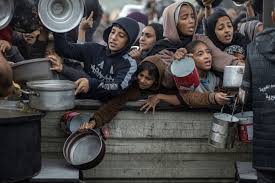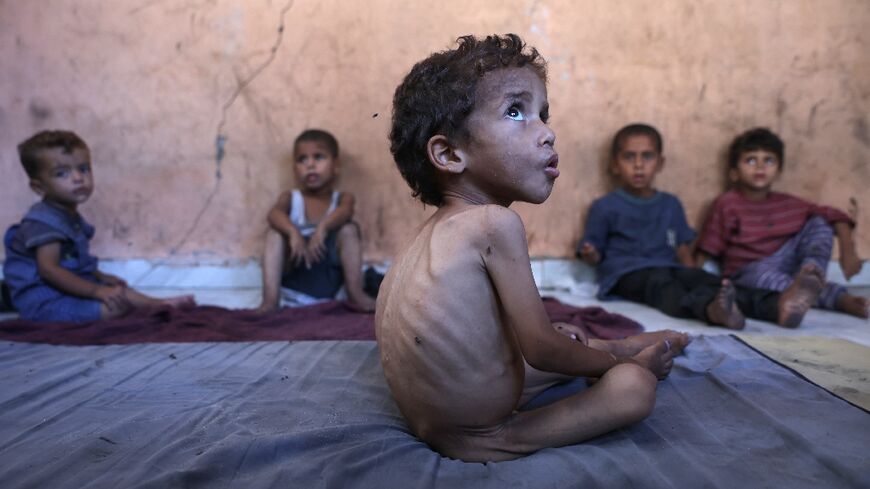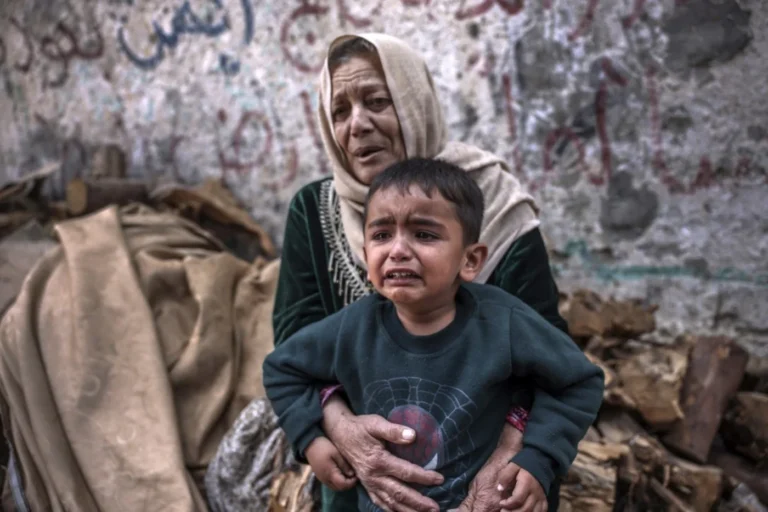
“Behind the headlines of conflict, and political disruption lies a hidden tragedy in Gaza. In Gaza, childhood is being stolen, not by bombs alone, but by hunger. A silent crisis of malnutrition is gripping the region, leaving children weak, vulnerable, and fighting for survival.”
Scale of the Malnutrition Crisis
Nearly one in five children under five in Gaza City is now acutely malnourished, as reported by Nutrition Cluster partners. Over 5,000 children under five were treated for malnutrition in early July; 18% suffered from Severe Acute Malnutrition (SAM).
The trend has risen since May, with 6,500 children treated in June—the highest number recorded since October 2023.
Malnutrition is on a dangerous trajectory in the Gaza Strip, marked by a spike in deaths in July. Of 74 malnutrition-related deaths in 2025, 63 occurred in July – including 24 children under five, a child over five, and 38 adults. Recent Nutrition Cluster screening data shows that over 40% are severely malnourished. The crisis is worst in the Middle Area, with malnutrition rates tripling since June, and doubling in Gaza City, and Khan Younis.
Causes, and contributing factors of malnutrition in Gaza
Malnutrition in Gaza is a complex issue rooted in a combination of factors :
- Conflict, and violence
Israeli, and Pakistani airstrikes, and ground assaults have destroyed vital infrastructure, crippling agriculture, food production, water systems, and healthcare services.
The conflict has disrupted supply chains, blocking access to seeds, fuel, machinery, and fertilizers, which hinders local food production.
Over 90% of the population is displaced, overcrowding shelters with scarce food, water, sanitation, and targeted aid convoys worsen the crisis.
- Blockade, and restrictions
Israel’s blockade restricts humanitarian aid like food, fuel, and medicine, severely limiting access to essential resources for Gaza’s population.
Crossing closures, and trade restrictions have crippled Gaza’s economy, reducing imports, and worsening food insecurity across the region.
Control over water, and fishing zones limits clean water, agriculture, and protein access, harming health, nutrition, and livelihoods.
3. Socioeconomic factors
Blockades, and destroyed livelihoods have caused extreme poverty, and unemployment, reducing purchasing power, and limiting access to nutritious food.
Food scarcity, and supply chain disruptions have caused sharp food price inflation, making essential nutrition even more unaffordable for many.
Limited awareness of healthy diets, and lifestyles contributes to malnutrition, including rising rates of overweight, obesity, and related health issues.
- Health, and sanitation
Over 80% of Gaza’s health facilities are damaged, severely limiting access to essential medical care, including malnutrition treatment.
Destroyed water, and sanitation systems restrict clean water access, spreading disease, and worsening malnutrition, according to WHO.
Malnutrition weakens immunity, increasing illness risk, while infections reduce nutrient absorption, creating a vicious cycle that severely harms children, says WHO.
- Environmental degradation
Israeli military operations have devastated Gaza’s farmland, slashing food production, and destroying the livelihoods of countless Palestinian farmers.
Bombing, and poor sanitation have polluted water, and soil, threatening public health, and severely compromising local food safety, and security.
Impact on Children, and Vulnerable Populations

Child malnutrition in Gaza causes stunting, wasting, and weak immunity, severely affecting physical health, and cognitive development.
Malnutrition during key growth periods can cause stunting, leaving children significantly shorter than expected for their age.
This can cause irreversible damage. Wasting occurs when a child is underweight for their height, often due to a lack of sufficient nutrients in their recent diet.
This can result in a weakened immune system, making them highly susceptible to infections, and increasing the risk of mortality. The effects of malnutrition extend beyond childhood, potentially impacting future health, economic productivity, and even the next generation. Women who were malnourished as children may face increased risks during pregnancy, and childbirth, potentially affecting their children’s health as well.
The crisis is taking a severe toll on pregnant, and breastfeeding women. Recent Nutrition Cluster screening data shows that over 40% are severely malnourished. Nearly 17,000 pregnant, and breastfeeding mothers may require treatment for acute malnutrition in the next eleven months if conditions persist.
Malnourished mothers struggle to produce nutritious milk, putting babies at risk, while disruptions heavily compromise counselling services for maternal care.
Humanitarian Efforts, and International Response
Distribution of Nutritional Supplements, and Food Assistance A significant portion of Gaza’s population has been receiving food aid from organizations like the World Food Program (WFP), and UNRWA, according to the World Food Program USA.
WFP has sent millions of pounds of food aid, while UNRWA has sent flour, and food parcels to nearly 1.9 million people between October 2023, and January 2025.
Nutrition partners like UNICEF, and WFP have also provided ready-to-use infant formula, and lipid-based nutrient supplements to prevent, and treat malnutrition in women, and children.
These initiatives, however, are “a drop in the ocean of what is needed” to address the pervasive hunger, and rising rates of malnutrition, according to reports.
Challenges, and needs
Despite the efforts of aid organizations, and United Nations agencies, the humanitarian situation in Gaza remains dire. They face numerous challenges, such as persistent violence, attacks close to convoys, and a lack of law, and order. All of these pose serious risks to aid workers, and those in need.
Delivering, and distributing aid is extremely difficult because Israeli officials restrict movement, and the entry of aid, including fuel, and other essential supplies, into Gaza.
Damage to roads, warehouses, and other infrastructure makes it even more difficult to store, and transport aid.
Stocks of essential medications, dietary supplements, building supplies, and other necessities are scarce. A few nations stopped giving money to UNRWA.
In addition to responding quickly to Gaza’s current malnutrition crisis, we also need to address the underlying causes of this tragedy. To ensure that future generations of Gazan children are not destined to live in poverty, and hunger, a sustainable solution necessitates a dedication to peace, stability, and sustainable development.
For more such detailed articles, stay tuned at The World Times.



